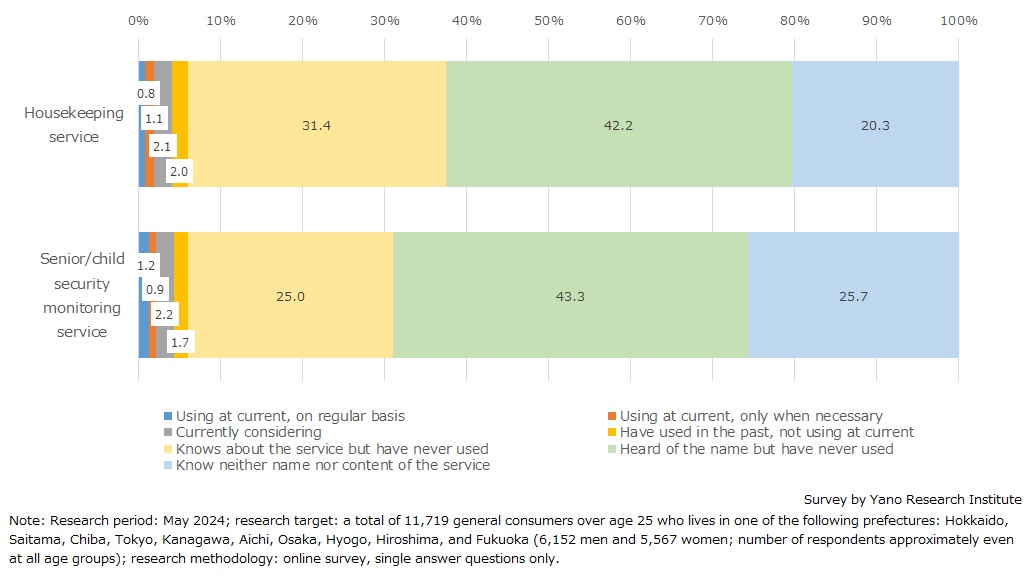No.3573
Consumer Survey on Living Assistance Services in Japan: Key Research Findings 2024
Usage Rate Of Living Assistance Services On The Rise
Yano Research Institute (the President, Takashi Mizukoshi) has conducted a consumer survey in Japan regarding living assistance services. Target of the survey include both users and prospective users. The results are compared to that of the same survey conducted in 2022. This press release shares some of the findings.

Summary of Research Findings
In May 2024, an online survey was carried out to a total of 11,719 general consumers at their age over 25, who lives in Hokkaido, Saitama, Chiba, Tokyo, Kanagawa, Aichi, Osaka, Hyogo, Hiroshima, and Fukuoka (6,152 men and 5,567 women; number of respondents approximately even at all age groups). This press release highlights the consumer trends on the use of housekeeping service and senior/child safety monitoring service.
Usage rate* of "housekeeping service" was 1.9% (1.3% for 2022 survey). While housekeeping services are basically household chores like doing laundry and cleaning the house, in recent years consumer attention is garnered around services such as personal grocery shopper.
Usage rate* of "senior/child safety monitoring service" rose to 2.1% (1.4% for 2022 survey). The services enable remote monitoring the safety of senior family members and children, and thus contractors are the ones that wish to monitor, not the ones to be monitored. The survey showed that users (contractors) value the service highly.
Note: “Usage rate” indicates a total percentage point of "using the services at current, on regular basis" and "using the services at current, only when necessary".
Noteworthy Topics
Changes in Working Environment Relate to Usage Rate of Living Assistance Services
In the consumer survey, we also analyzed the relation between the changes in working environment*1 brought about by COVID-19 and the usage rate of home and living assistance services.
When the transition of the usage rates from pre-pandemic period (before 2019, approximately five years ago) to pandemic period (the year-end of 2019 to May 2023) is observed, the usage rate among those that “work mainly at office” dropped by 11.4 percentage points (66.0% to 54.6%), while that of those that “work mainly from home” rose by 10.6 percentage points (from 5.5% to 16.1%).
In the post-pandemic period (after the reclassification of COVID-19 to category 5 disease, from May 2023) to date (April 2024), the usage rate of those “work mainly at office” showed marginal increase, while a decline was witnessed for those “work mainly from home”. Still, not much change has occurred on either segment.
While many people had no choice but to change working environment during the pandemic, work from home has taken root in the post-pandemic society as a new work style. Usage rates of home and living assistance services*2 among general consumers that have shifted from “work mainly at office” to “work mainly from home” around the pandemic period were generally higher than those that did not change their working environment. Although various backgrounds and reasons can be speculated for the trend for each service, all in all, the survey results suggested that changes in working environment impact the usage rate of home and living assistance services.
*1. Responses by a total of 11,719 general consumers of the main survey (6,152 men and 5,567 women, number of respondents approximately even at all age groups), to questions asking their working environment in pre-pandemic period (before 2019, approximately five years ago), pandemic period (the year-end of 2019 to May 2023), and today (April 2024 onward)
*2 The home and living assistance services for the main survey includes housekeeping service, home security service, senior/child safety monitoring service, house-cleaning service [professional cleaner], furniture & home electric appliances rental service, laundry delivery & pickup service, emergency service, delivery locker service, and grocery truck.
Research Outline
2.Research Object: A total of 11,719 general consumers at their age over 25, living in one of the following prefectures: Hokkaido, Saitama, Chiba, Tokyo, Kanagawa, Aichi, Osaka, Hyogo, Hiroshima, and Fukuoka (6,152 men and 5,567 women; number of respondents approximately even at all age groups)
3.Research Methogology: Online survey
What is the Consumer Survey on Living Assistance Services?
An online survey was conducted in May 2024 to a total of 11,719 general consumers at their age over 25 (6,152 men and 5,567 women; number of respondents approximately even at all age groups), who resides in one of the ten target prefectures (Hokkaido, Saitama, Chiba, Tokyo, Kanagawa, Aichi, Osaka, Hyogo, Hiroshima, and Fukuoka). The survey was designed to analyze the trend regarding the current and potential use of living assistance services (housekeeping service, home security service, senior/child safety monitoring service, house-cleaning service [professional cleaner], furniture & home electric appliances rental service, laundry delivery & pickup service, emergency service, delivery locker service, and grocery truck). This press release highlights the consumer usage trends on two major living assistance services, i.e., housekeeping service and senior/child safety monitoring service, and shares our analysis on the correlation between the changes in working environment after the COVID-19 and the usage rate of living assistance services.
<Products and Services in the Market>
Housekeeping service, home security service, senior/child safety monitoring service, house-cleaning service (professional cleaner), furniture & home electric appliances rental service, laundry delivery & pickup service, emergency service, delivery locker service, grocery truck (supermarket on wheels)
Published Report
Contact Us
The copyright and all other rights pertaining to this report belong to Yano Research Institute.
Please contact our PR team when quoting the report contents for the purpose other than media coverage.
Depending on the purpose of using our report, we may ask you to present your sentences for confirmation beforehand.